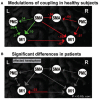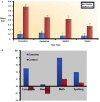Thinking, Walking, Talking: Integratory Motor and Cognitive Brain Function
- PMID: 27252937
- PMCID: PMC4879139
- DOI: 10.3389/fpubh.2016.00094
Thinking, Walking, Talking: Integratory Motor and Cognitive Brain Function
Abstract
In this article, we argue that motor and cognitive processes are functionally related and most likely share a similar evolutionary history. This is supported by clinical and neural data showing that some brain regions integrate both motor and cognitive functions. In addition, we also argue that cognitive processes coincide with complex motor output. Further, we also review data that support the converse notion that motor processes can contribute to cognitive function, as found by many rehabilitation and aerobic exercise training programs. Support is provided for motor and cognitive processes possessing dynamic bidirectional influences on each other.
Keywords: basal ganglia; cerebellum; cognitive processes; cognitive–motor interaction; executive function; motor processes; prefrontal cortex; premotor cortex.
Figures











References
-
- Harcourt-Smith WHE. The first hominins and the origins of bipedalism. Evol Educ Outreach (2010) 3(3):333–40.
-
- Melillo R, Leisman G. Neurobehavioral Disorders of Childhood: An Evolutionary Approach. New York, NY: Springer; (2009). 2009 p.
-
- Vercruyssen M, Simonton K. Effects of posture on mental performance: we think faster on our feet than on our seat. In: Lueder R, Noro K, editors. Hard Facts about Soft Machines: The Ergonomics of Seating. Bristol, PA: Taylor & Francis; (1994). p. 119–32.
Publication types
LinkOut - more resources
Full Text Sources
Other Literature Sources
Medical

